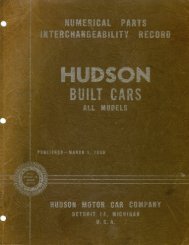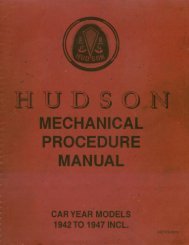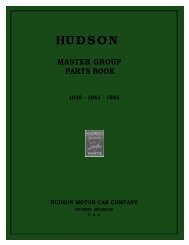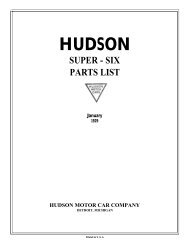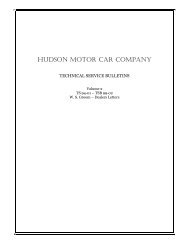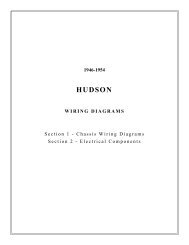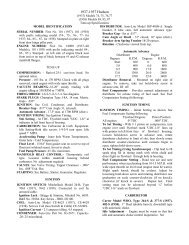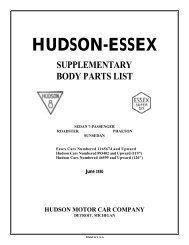1948-1952 Shop Service Manual - - Hudson-Essex-Terraplane Club
1948-1952 Shop Service Manual - - Hudson-Essex-Terraplane Club
1948-1952 Shop Service Manual - - Hudson-Essex-Terraplane Club
Create successful ePaper yourself
Turn your PDF publications into a flip-book with our unique Google optimized e-Paper software.
ENGINE TUNE-UP 2 -11<br />
VACUUM ADVANCE ADJUSTMENT:<br />
Vacuum advance should be checked on a distributor test<br />
fixture that has a controlled source of vacuum and a vacuum<br />
gauge.<br />
1. Place distributor in the distributor clamp and tighten<br />
securely with the hand wheel at the right side of clamp.<br />
2. Adjust the vertical screw so distributor shaft fits down into<br />
the drive chuck.<br />
3. Use special wrench to tighten the distributor shaft in the<br />
drive chuck.<br />
4. Connect red tipped distributor lead to binding post at the<br />
side of the distributor.<br />
5. Attach vacuum pump connection.<br />
6. Turn cam lobe switch to Battery Check position. Tachometer<br />
indicating hand should read in bar at right end of<br />
scale.<br />
7. Test distributor point spring tension scale. The spring<br />
tension is 17 to 20 ounces on both the six and eight<br />
cylinder distributors.<br />
8. Turn on battery switch at left side of tester head.<br />
9. With cam lobe switch in the 6-lobe position and distributor<br />
contact points closed, the dwell meter indicating hand<br />
must read in the black bar for satisfactory point resistance.<br />
If the reading is in the red band, it indicates dirty<br />
contact points, loose connections, or resistance within<br />
the distributor circuit.<br />
10. Turn the motor drive switch to right hand rotation and<br />
adjust the speed control<br />
crank until the Tachometer reads 200 R.P.M.<br />
11. Adjust the distributor contact points until proper degrees<br />
of dwell is indicated.<br />
12. Turn graduated degree ring until the arrow flash appears<br />
at 0.<br />
13. Then check to see if all flashes appear at 60 degree<br />
intervals for the <strong>Hudson</strong> Six and at 45 degree intervals<br />
for the <strong>Hudson</strong> Eight. If the f lashes do not<br />
appear to within one degree of the respective angles,<br />
it indicates an inaccurate cam.<br />
14. Turn vacuum switch to the "ON" position.<br />
15. Set degree ring so arrow will be on zero at a most<br />
convenient point to read.<br />
16. Adjust vacuum regulator to obtain correct reading on<br />
vacuum regulator for exact p o n t the vacuum advance<br />
starts to operate, and compare with specifications. Adjust<br />
the vacuum regulator to each specification and check the<br />
arrow flash on the degree ring.<br />
17. Watch the arrow on the degree ring as the vacuum<br />
regulator is adjusted to the point vacuum advance starts<br />
to operate. Compare the reading with specifications and<br />
adjust the vacuum regulator to each specification and<br />
check the arrow flash on the degree ring.<br />
18. If the degree indicated on ring is more than specified, the<br />
unit is advancing too quickly showing the return spring<br />
is too weak.<br />
19. If the degree indicated on the ring is less than the specifications,<br />
the unit is advancing too slow ly showing the<br />
return spring is too strong.<br />
20. Vacuum advance characteristics are varied by changing<br />
the spring pressure or by inserting or removing washers<br />
under the end of the spring in the vacuum chamber.<br />
AUTOMATIC ADVANCE CURVE:<br />
1. Adjust speed control so that distributor will rotate at the<br />
lowest R.P.M.<br />
2. Set degree ring so arrow will flash at zero at a point most<br />
convenient to read.<br />
3. Increase distributor R.P.M. to correspond with specifications<br />
marked "Start".<br />
4. Check the R.P.M. required to advance the arrow flash to<br />
the first specification given.<br />
NOTE: Be sure the advance is opposite the rotation of the<br />
distributor shaft.<br />
5. Continue to check the advance curve R.P.M. against<br />
degree of advance and compare this with specifications.



